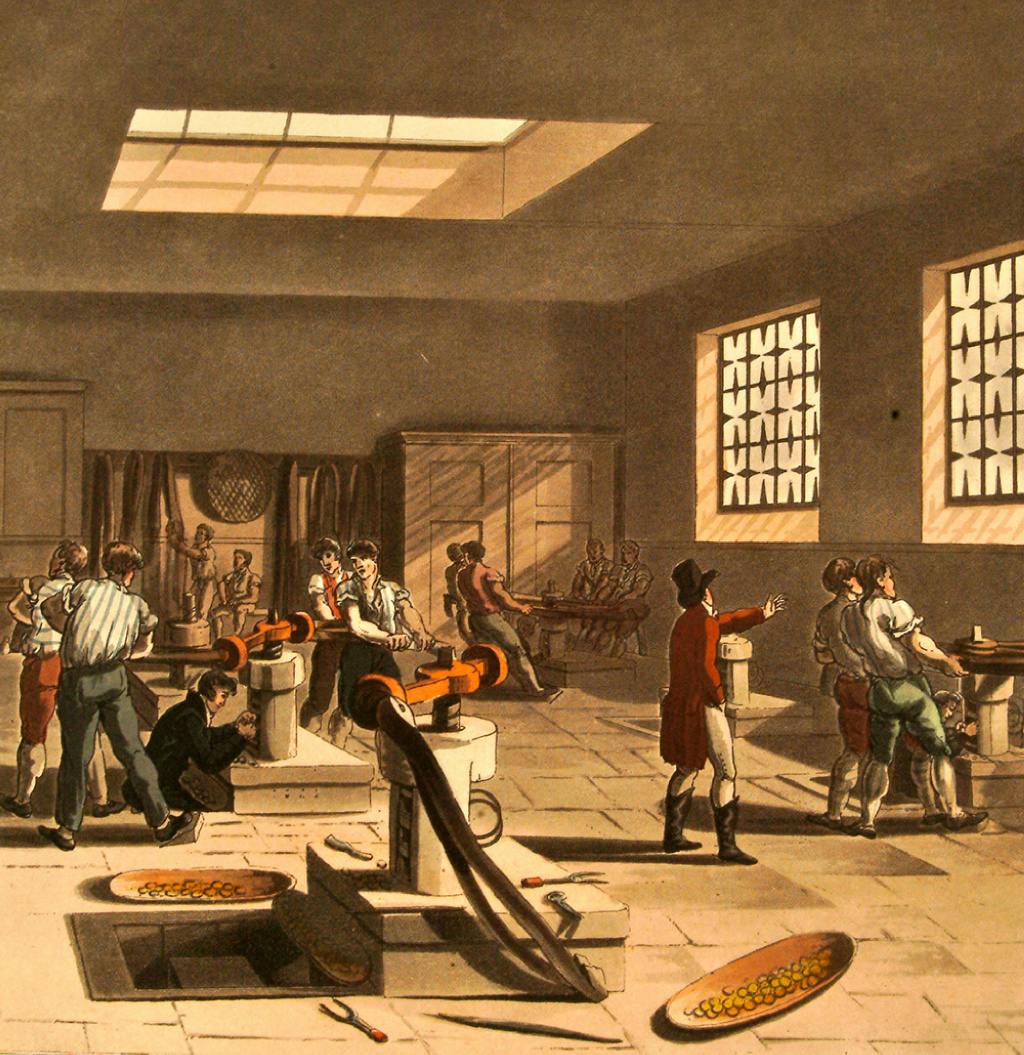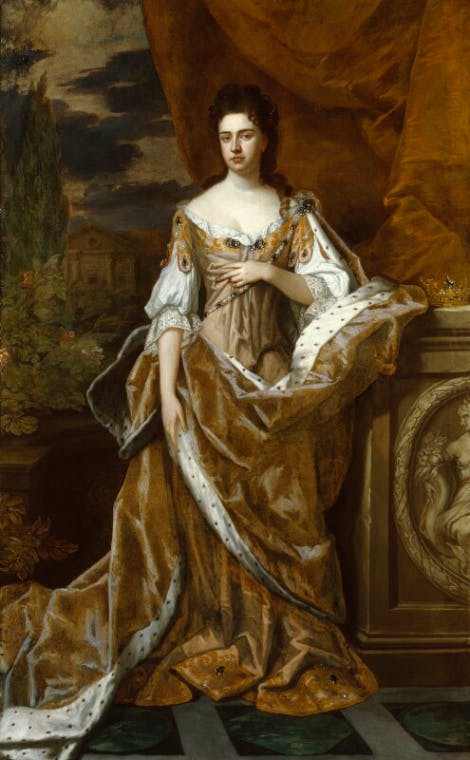
The Mint made the majority of the country’s coins for over 500 years
Maximum security Mint
Edward I (1272-1307) installed the Mint within the safety of the Tower’s walls in c1279 and until 1810, most of the coins of the realm were made there in a dedicated area that became known as Mint Street. Making coins was hot, noisy and dangerous. Tampering with coins was treason, and the threat of horrific punishment deterred most, if not all, thieves and forgers.
Header image: Engraving by John Bluck (Active 1791-1831) after artwork by Thomas Rowlandson (1756-1827) & Auguste Charles Pugin (1762-1832) from a publication titled "The Microcosm of London", R. Ackermann (London 1808-11) (Plate 53), R. Ackermann's Respository of Arts, 101, Strand, London, 1 February 1809.

Image: Conditions in the Mint as imagined by an illustrator of 1270, showing Mint administration, coin shearing and weighing, coin striking, and annealing in the fire.
Mint Street
The making of coins was rather a different business from the usual activities at the Tower. Mint staff were kept separate from the rest of the community within the fortress, and their comings and goings were strictly monitored. The Mint operated from a series of closely guarded temporary workshops, and more permanent factory buildings in the Outer Ward, which became known as Mint Street.
Danger money
The Mint was hot and noisy, with huge fiery furnaces used to melt down the precious metals. The air was full of deadly chemicals and poisonous gases. Until mechanisation in the 1600s, coins were all made by hand. One man would place a handmade piece of metal between two engraved stamps called dies, and then another struck it with a hammer. Split second timing and staying alert could mean the difference between making a coin and losing a finger!
Did you know?
It was dirty and dangerous work. Few Mint workers escaped uninjured and the loss of fingers and eyes was common.

Image: Men minting coins © World History Archive / TopFoto
The Art of Coining
Life for Mint workers became relatively safe after the introduction of screw-operated presses, like the one shown in this engraving of 1750.
Treason!
Coins were stamped with the face of the monarch, and for the majority of their subjects this was the only way that they could see what their king or queen looked like. Any tampering or forgery, for example clipping (shaving silver from the edges of a coin to steal it) was treason, and punishments were severe.
Warden of the Mint, Isaac Newton, was so good at catching counterfeiters that he was made Master of the Mint in 1699.
In the medieval period, even for a first offence a convicted counterfeiter had his right hand removed; any further offence was punishable by castration.
In later years forgers suffered a traitor’s death of hanging, drawing and quartering, while women were burned at the stake, or transported on one of the infamous convict ships, right up until the 1700s.

Image: Sample of silver coins that would've been in circulation in the 1690s © Historic Royal Palaces.
England hath been more grieved with Clipt and Counterfeit money than any other country through want of law...
William Chaloner, Master Forger, 1694
A deadly business
Mint workers' health and safety was not a priority. The mixture of toxic chemicals that were needed to create coins posed a real hazard. In the 1540s, a potter at the Mint fell asleep over his pots, and no one could wake him. It’s said even Henry VIII himself came to the Tower to poke the unfortunate sleeping beauty. It’s not clear what caused William Foxley’s coma, but he woke up after 14 days perfectly well. He lived another 40 years.
Less fortunate were a group of German workers. In 1560 several of them fell badly ill, possibly poisoned by clouds of noxious gas. Old hands at the Mint advised them to drink milk – from a human skull! Despite taking the ‘cure’, several men died.
Mint today
The Mint expanded over the centuries as the country’s economy grew. By the 1500s the Mint had spread along all the west, north and east walls of the fortress.
In 1810 the Mint moved out of the Tower to a new building on Tower Hill, then to its present home in Wales in the 1960s.
Browse more history and stories

LGBT Royal Histories
Lesbian, Gay, Bisexual, Trans and Queer histories in our palaces

The Tower of London and the Second World War
Life at the Tower of London during the Second World War

Yeoman Warders at the Tower of London
The ‘Beefeaters’ have been guarding the Tower since Tudor times
Explore what's on

- Things to see
The Tower's Mint
Discover the people and stories behind the Royal Mint at the Tower of London.
-
Open
- Tower of London
- Included in palace admission (Members go free)

- For members
- Events
Members-only Ceremony of the Keys
Members-only access to the traditional locking up of the Tower of London, the Ceremony of the Keys.
-
13 July, 24 August, 14 September 2025
- 21:30
- Tower of London
- Separate ticket (advance booking required)

- Things to see
The Tower Moat
Take a relaxing stroll through the west side of the Tower Moat
-
Closed
- Tower of London
- Included in palace admission (Members go free)
Shop online

Guy Fawkes Decoration
This luxury fabric hanging decoration commemorates the infamous attempt of Guy Fawkes to assassinate King James I during the State Opening of Parliament on November 5th, 1605.
£13

Crown of India Snow Globe
The Imperial State Crown of India, set with fabulous gems from India and other countries, is one of the heaviest crowns in the Crown Jewels collection with more than 6000 diamonds.
£15

Shop Hanging Decorations
Browse through our beautiful range of hanging decorations, ornaments and baubles including unique and hand-made pieces.
From £5.50
